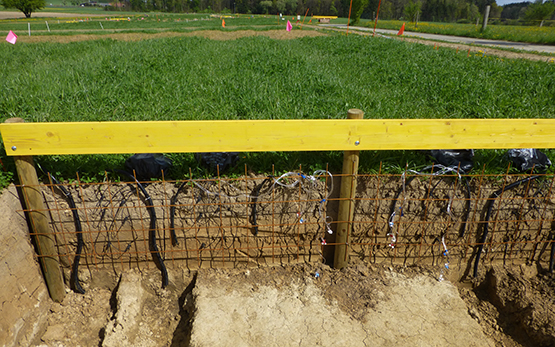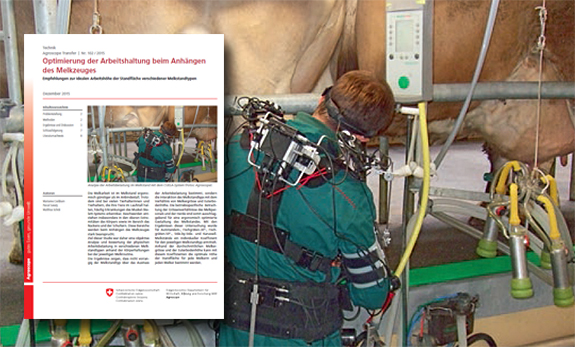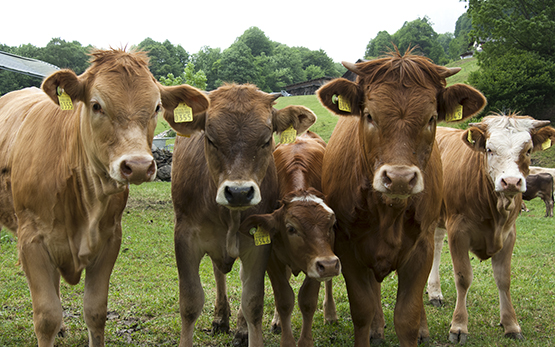Cornelissen G., Briels N., Bucheli T., Estoppey N., Gredelj A., Hagemann N., Lerch S., Lotz S., Rasse D., Schmidt H.-P., Sormo E., Arp H. P. H.
A virtuous cycle of phytoremediation, pyrolysis, and biochar applications toward safe PFAS levels in soil, feed, and food.
Journal of Agricultural and Food Chemistry, 73, (6), 2025, 3283-3285.
Grafmüller J., Möllmer J., Muehe E. M., Kammann C. I., Kray D., Schmidt H.-P., Hagemann N.
Granulation compared to co-application of biochar plus mineral fertilizer and its impacts on crop growth and nutrient leaching.
Scientific Reports, 14, 2024, Article 16555.
Zhuang Y., Spahr S., Lutze H. V., Reith C. J., Hagemann N., Paul A., Haderlein S. B.
Persulfate activation by biochar and iron: Effect of chloride on formation of reactive species and transformation of N, N-diethyl-m-toluamide (DEET).
Water Research, 265, 2024, Article 122267.
Grafmüller J., Rathnayake Mudiyanselage D. C., Hagemann N., Bucheli T., Schmidt H.-P.
Biochars from chlorine-rich feedstock are low in polychlorinated dioxins, furans and biphenyls.
Journal of Analytical and Applied Pyrolysis, 183, 2024, Article 106746.
Lotz S., Bucheli T., Schmidt H.-P., Hagemann N.
Quantification of soil organic carbon: the challenge of biochar-induced spatial heterogeneity.
Frontiers in Climate, 6, 2024, Article 1344524.
Buss W., Wurzer C., Shepherd J. G., Bucheli T.
Organic contaminants in biochar.
In: Biochar for Environmental Management: Science, Technology and Implementation. 3rd ed., Publ. J. Lehmann & S. Joseph, Routledge. 2024, 559-587.
Goranov A. I., Sørmo E., Hagemann N., Cornelissen G., Zimmerman A. R., Hatcher P. G.
Using the benzenepolycarboxylic acid (BPCA) method to assess activated biochars and their PFAS sorption abilities.
Chemosphere, 355, 2024, 1-9.
Hagemann N.
Herstellung von Aktivkohle aus sekundären Biomassen: Zertifizierung von Aktivkohle.
In: DWA-Expertengespräch "Aktivkohlen aus Biomasse für eine nachhaltige Abwasserreinigung - Forschung trifft Praxis". 21. März, Publ. Deutsche Vereinigung für Wasserwirtschaft, Abwasser und Abfall e.V., Kassel. 2024, 1-30.
Hagemann N.
Pflanzenkohle und Agroforstsysteme.
In: Agroforst Akademie des Deutscher Fachverband für Agroforstwirtschaft (DeFAF). 27. Februar, online. 2024, 1-49.
Rathnayake D., Schmidt H.-P., Leifeld J., Bürge D., Bucheli T., Hagemann N.
Quantifying soil organic carbon after biochar application: How to avoid (the risk of) counting CDR twice?
Hagemann N.
Pflanzenkohle und ihre Anwendungen: Eine Einführung.
In: German Biochar Forum. 14. November, Berlin. 2023, 1-18.
Hagemann N.
Pyrogenic carbon capture and storage: Negative emissions made by plants and fire.
In: CLIMACT seminar series. 30 October, online. 2023, 1-24.
Hagemann N.
Biochar in agriculture.
In: Professional Exchange. 18. Juni, Publ. Verein zur Dekarbonisierung der Industrie, online. 2023, 1-14.
Rathnayake D., Schmidt H.-P., Leifeld J., Mayer J., Epper C., Bucheli T., Hagemann N.
Biochar from animal manure: A critical assessment on technical feasibility, economic viability, and ecological impact.
Global Change Biology Bioenergy, 15, (9), 2023, 1078-1104.
Bucheli T., Hilber Schöb I., Schmidt H.-P., Hagemann N.
Polyzyklische aromatische Kohlenwasserstoffe (PAK) in Pflanzenkohle: Früher unbekannt – heute bestbekannt.
In: Pflanzenkohle-Fachtagung 2023. 16. Juni, Publ. Charnet – Schweizer Fachverband für Pflanzenkohle, Brugg-Windisch. 2023.
Hagemann N.
Zukünftige Herausforderungen für Böden und Beitrag der Pflanzenkohle zu deren Bewältigung.
In: Pflanzenkohle-Fachtagung 2023. 16. Juni, Publ. Charnet – Schweizer Fachverband für Pflanzenkohle, Brugg-Windisch. 2023, 1-15.
Meyer zu Drewer J., Abiven S., Hagemann N., Schmidt H.-P.
Permanence of soil applied biochar: Conclusions from the natural pyrogenic carbon cycle validate carbon sink accounting.
In: EGU General Assembly 2023. 25 April, Publ. European Geosciences Union (EGU), Vienna (AT). 2023, 1-2.
Hagemann N., Conte P., Leifeld J., Giger R., Bucheli T., Schmidt H.-P., Grafmüller J.
Impact of biomass ash content on biochar carbon speciation and stability.
In: EGU General Assembly 2023. 25 April, Publ. European Geosciences Union (EGU), Vienna (AT). 2023, 1.
Grafmüller J., Kray D., Kammann C., Mühe E. M., Schmidt H.-P., Hagemann N.
Granulated biochar-based NPK fertilizer and its impact on nutrient leaching, plant growth and soil-borne N2O emissions.
In: EGU General Assembly 2023. 23-28 April, Publ. European Geosciences Union (EGU), Vienna (AT). 2023.
Sigmund G., Schmid A., Schmidt H.-P., Hagemann N., Bucheli T., Hofmann T.
Sometimes size matters – new insights into the physical disintegration of biochar.
In: EGU General Assembly 2023. 28 April, Publ. European Geosciences Union (EGU), Vienna (AT). 2023, 1.
Sigmund G., Schmid A., Schmidt H.P., Hagemann N., Bucheli T., Hofmann T.
Small biochar particles hardly disintegrate under cryo-stress.
Geoderma, 430, 2023, 1-6.
Chiaia-Hernandez A.C., Casado-Martinez C., Lara-Martin P., Bucheli T.
Sediments: sink, archive, and source of contaminants.
Environmental Science and Pollution Research, 29, 2022, 85761-85765.
Hagemann N., Schmidt H.-P.
EBC-Certification of biochar made from biosolids.
In: 1st Swedish Conference on Sewage Sludge Biochar. 12. Oktober, Sweden Water Research AB, Malmö. 2022.
Spahr S., Teixidó M., Gall S. , Pritchard J., Hagemann N., Helmreich B., Luthy R.
Performance of biochars for the elimination of trace organic contaminants and metals from urban stormwater.
Environmental Science: Water Research & Technology, 8, 2022, 1287-1299.
Hilber Schöb I., Blum F., Schmidt H.P., Bucheli T.
Current analytical methods to quantify PAHs in activated carbon and vegetable carbon (E153) are not fit for purpose.
Environmental Pollution, 309, 2022, 1-8.
Grafmüller J., Schmidt H. P., Kray D., Hagemann N.
Root-Zone amendments of biochar-based fertilizers: Yield increases of white cabbage in temperate climate.
Horticulturae, 8, (4), 2022, 1-17.
Grafmüller J., Böhm A., Zhuang Y., Spahr S., Müller P., Otto T. N., Bucheli T., Leifeld J., Giger R., Tobler M., Schmidt H. P., Dahmen N., Hagemann N.
Wood ash as an additive in biomass pyrolysis: Effects on biochar yield, properties, and agricultural performance.
ACS Sustainable Chemistry & Engineering, 10, (8), 2022, 2720-2729.
Buss W., Hilber Schöb I., Graham M.C., Masek O.
Composition of PAHs in Biochar and Implications for Biochar Production.
ACS Sustainable Chemistry & Engineering, 10, 2022, 6755-6765.
Hama J. R., Garcia Jorgensen D. B., Diamantopoulos E., Bucheli T., Bruun Hansen H. C., Strobel B. W.
Indole and quinolizidine alkaloids from blue lupin leach to agricultural drainage water.
Science of the Total Environment, 834, 2022, 1-10.
Sigmund G., Arp H.P.H., Aumeier B.M., Bucheli T., Chefetz B., Chen W., Droge S.T.J., Endo S., Escher B.I., Hale S.E., Hofmann T., Pignatello J., Reemtsma T., Schmidt T.C., Schönsee C. and others
Sorption and Mobility of Charged Organic Compounds: How to Confront and Overcome Limitations in Their Assessment.
Environmental Science & Technology, 56, (8), 2022, 4702-4710.
Meyer zu Drewer, J, Köster, M, Abdulai, I, Rötter, M P, Hagemann N., Schmidt, H-P
Impact of different methods of root-zone application of biochar-based fertilizers on young cocoa plants: insights from a pot-trial.
Horticulturae, 222, (8), 2022, 328-342.









